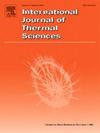Entropy optimization and Prandtl-Eyring non-Newtonian fluid flow with second-order slip conditions past a curved Riga sheet; numerical simulation
IF 4.9
2区 工程技术
Q1 ENGINEERING, MECHANICAL
International Journal of Thermal Sciences
Pub Date : 2025-04-04
DOI:10.1016/j.ijthermalsci.2025.109916
引用次数: 0
Abstract
The non-Newtonian (NN) Prandtl-Eyring fluid (PEF) model can be used to optimize conditions for processing, ensure substance high quality and consistency, and anticipate melted polymer flow behavior. This paper looks into an intriguing feature of irreversibility estimation through NN-PEF flow over a curved Riga surface. The impact of second-order slip conditions, thermal radiation, and exponential heat source/sink are also elaborated. The flow equations of NN-PEF have been reformulated into a dimensionless representation of differential equations (DEs) with an application of similarity conversions. The obtained lowest-order differential equations are numerically solved through the PCM (parametric continuation method). For accuracy of the results, the outcomes are compared to both experimental and theoretical results. The relative percent error between the present findings and the published numerical results at Re = 5000 is 0.71094 %. The rate of heat transfer (W/m2K) enhances from 4238.0724 to 44390.4205 at Re = 1594 to 440. The relative error between published experimental and present results is about 0.0029 % at Re = 440, which ensures the reliability of the proposed model and applied methodology. The velocity field of PEF is significantly boosted with the positive variation in 1st and 2nd order slip parameters. The influence of the Brinkmann number and heat radiation factor is enhanced, while the consequences of the temperature ratio parameter drop the rate of entropy generation in the system.
二阶滑移条件下非牛顿流体的熵优化与Prandtl-Eyring流动数值模拟
非牛顿(NN) Prandtl-Eyring流体(PEF)模型可用于优化加工条件,确保物质的高质量和一致性,并预测熔融聚合物的流动行为。本文研究了利用NN-PEF流在弯曲里加曲面上的不可逆性估计的一个有趣的特征。对二阶滑移条件、热辐射和指数热源/汇的影响也进行了阐述。利用相似转换将NN-PEF的流动方程重新表述为微分方程的无量纲表示。通过参数延拓法对得到的最低阶微分方程进行数值求解。为了保证计算结果的准确性,将计算结果与实验结果和理论结果进行了比较。在Re = 5000处,本研究结果与已发表的数值结果之间的相对误差百分比为0.71094%。Re = 1594 ~ 440时,换热率(W/m2K)从4238.0724增加到44390.4205。在Re = 440时,已发表的实验结果与本文结果的相对误差约为0.0029%,保证了所提出模型和应用方法的可靠性。随着一阶和二阶滑移参数的正变化,PEF的速度场显著增强。布林克曼数和热辐射因子的影响增强,而温比参数的影响降低了系统的熵产率。
本文章由计算机程序翻译,如有差异,请以英文原文为准。
求助全文
约1分钟内获得全文
求助全文
来源期刊

International Journal of Thermal Sciences
工程技术-工程:机械
CiteScore
8.10
自引率
11.10%
发文量
531
审稿时长
55 days
期刊介绍:
The International Journal of Thermal Sciences is a journal devoted to the publication of fundamental studies on the physics of transfer processes in general, with an emphasis on thermal aspects and also applied research on various processes, energy systems and the environment. Articles are published in English and French, and are subject to peer review.
The fundamental subjects considered within the scope of the journal are:
* Heat and relevant mass transfer at all scales (nano, micro and macro) and in all types of material (heterogeneous, composites, biological,...) and fluid flow
* Forced, natural or mixed convection in reactive or non-reactive media
* Single or multi–phase fluid flow with or without phase change
* Near–and far–field radiative heat transfer
* Combined modes of heat transfer in complex systems (for example, plasmas, biological, geological,...)
* Multiscale modelling
The applied research topics include:
* Heat exchangers, heat pipes, cooling processes
* Transport phenomena taking place in industrial processes (chemical, food and agricultural, metallurgical, space and aeronautical, automobile industries)
* Nano–and micro–technology for energy, space, biosystems and devices
* Heat transport analysis in advanced systems
* Impact of energy–related processes on environment, and emerging energy systems
The study of thermophysical properties of materials and fluids, thermal measurement techniques, inverse methods, and the developments of experimental methods are within the scope of the International Journal of Thermal Sciences which also covers the modelling, and numerical methods applied to thermal transfer.
 求助内容:
求助内容: 应助结果提醒方式:
应助结果提醒方式:


